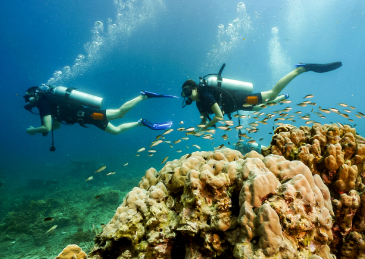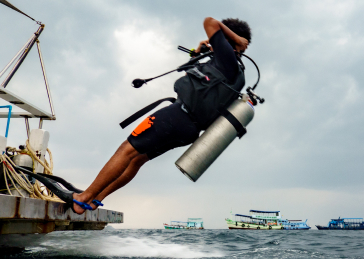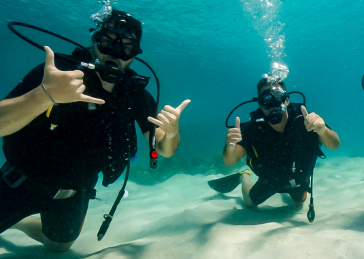24 de junio de 2024
Imagine diving into the clear waters of Koh Tao, where the colorful coral reefs amaze you and the fishes move in perfect sync. This island is more than just a speck on the globe; it’s a paradise for scuba divers, providing an underwater escapade that enthralls novices and experienced divers alike. With its warm waters and a variety of ecosystems, Koh Tao offers an undewater wonderland that guarantees an exciting dive every time.
Resumen
- Con más de 70 escuelas de buceo y una gran variedad de puntos de inmersión, Koh Tao es un destino privilegiado para la práctica del submarinismo.
- Hay muchas formas de llegar a Koh Tao desde Bangkok y otras grandes ciudades tailandesas.
- Al elegir una escuela de buceo, tenga en cuenta su historial de seguridad, la experiencia de sus instructores y los cursos que ofrecen.
- Don’t miss the chance to dive at Shark Island, Sail Rock, and Chumphon Pinnacle for an unforgettable underwater adventure.
- Always put safety and marine conservation first during your dives to help preserve Koh Tao’s fragile ecosystem.
Explore Koh Tao: A Scuba Diver’s Dream

Located in the Gulf of Thailand, Koh Tao – also known as ‘Turtle Island’ due to its shape – may be small, but it has a big reputation among divers. Thanks to its affordable dive certification courses, friendly local people, and relaxed island atmosphere, Koh Tao is the ideal spot to dive in and discover the wonders of the deep sea.
Por qué Koh Tao es un gran lugar para bucear
Koh Tao stands out as a diving paradise due to its amazing biodiversity. Its surrounding waters are teeming with a wide variety of marine life, from the smallest nudibranch to the grand whale shark. The coral formations are not just a home, but a lively, living art piece that captivates every diver. Additionally, Koh Tao’s diving spots are known for their ease of access, making it a perfect spot for both day and night dives.
However, what sets Koh Tao apart is not just its underwater beauty. The island’s dedication to conservation and sustainable diving helps to maintain its natural allure for future generations. As a diver, you can participate in this conservation effort, aiding in the protection of marine life while enjoying it fully.
Llegada a Koh Tao: El primer paso de su viaje submarino
Starting your Koh Tao diving experience is simple. The island is easy to reach from the mainland and other islands, with a variety of transport options to match your needs and budget. Most visitors choose to fly to Koh Samui before taking a fast ferry to Koh Tao, providing a beautiful and exciting beginning to the trip. Alternatively, you can catch a bus or train from Bangkok to Chumphon or Surat Thani before getting a ferry to the island. No matter which path you take, the journey is all part of the fun, paving the way for the amazing experiences that are waiting for you under the sea. You can also find an airport in Chumphon that’s cheaper to fly to than Koh Samui.
Elegir la escuela de buceo adecuada
After you’ve landed, the next thing on your agenda should be to pick a dive school. With the sheer number of choices available, it’s important to pick one that meets your needs and guarantees a safe, fun experience. Here are some things you should be on the lookout for: Consider schools that emphasize buceo ecológico y prácticas sostenibles para garantizar que sus aventuras submarinas también contribuyan positivamente al medio ambiente marino.
Qué buscar en una escuela de buceo
- Acreditación: Asegúrese de que la escuela está acreditada por organizaciones de prestigio como PADI, SSI o RAID. Esto garantiza que siguen las normas internacionales de seguridad y formación.
- Historial de seguridad: Una buena escuela de buceo da prioridad a la seguridad. Comprueba su historial de seguridad y el mantenimiento de su equipo.
- Credenciales de instructor: Your instructor’s experience and teaching style can make a big difference in your diving experience. Look for schools with experienced, patient, and enthusiastic instructors.
- Tamaño de la clase: Las clases reducidas ofrecen una atención más personalizada y un mejor entorno de aprendizaje.
- Esfuerzos de conservación: Choose a school that actively participates in marine conservation, as this shows their commitment to protecting the underwater world you’re about to explore.
Escuelas de buceo más recomendadas en Koh Tao
Aunque hay muchas escuelas de buceo excelentes en Koh Tao, algunas destacan por su excepcional servicio y su dedicación a ofrecer la mejor experiencia de buceo. Big Blue Diving es conocida por sus completos cursos y sus instructores profesionales, mientras que La Bombona Diving ofrece un entorno más íntimo, con grupos más reducidos y atención personalizada. Otra opción notable es la New Heaven Dive School, que pone un gran énfasis en la conservación y las prácticas de buceo ecológicas.
Pináculo de Chumphon: el hogar del tiburón ballena
Chumphon Pinnacle is a diver’s paradise located in Koh Tao. It’s an underwater mountain that provides an opportunity to swim with the sea’s gentle giants – whale sharks. The site is decorated with stunning anemones and schools of barracuda, creating a captivating spectacle that is ideal for photographers and nature enthusiasts.
Conocer los puntos de inmersión

Los puntos de inmersión de Koh Tao son tan variados como emocionantes. Cada lugar tiene su propio paisaje y vida marina. Desde jardines de coral poco profundos, perfectos para los que se inician en el buceo, hasta profundos pináculos y pecios que suponen un reto para los más avanzados, hay algo para todos los gustos. Saber qué ofrece cada punto de inmersión es clave para disfrutar de una inmersión satisfactoria.
Tiempos óptimos de inmersión: Las estaciones
Scuba diving in Koh Tao is excellent throughout the year, but it’s at its best from March to October when the sea is calm and visibility is at its best. During these months, marine life is at its most abundant, and the likelihood of seeing whale sharks at Chumphon Pinnacle is very high.
Por otro lado, si prefiere una experiencia menos masificada, la temporada baja, de noviembre a febrero, es perfecta. Puede que el mar esté un poco más agitado y la visibilidad sea algo menor, pero la abundancia de vida marina y los impresionantes puntos de inmersión permanecen inalterables.
Keep in mind, the Gulf of Thailand can undergo monsoon climate, so it’s always a good idea to check the local weather and predictions before scheduling your dives.
Example: A diver’s log from April – “Visibility was incredible at Chumphon Pinnacle today. We spotted a whale shark and a school of chevron barracuda. The water was warm, and the currents were gentle. Perfect dive conditions!”
Comprender las corrientes y la visibilidad para vivir la mejor experiencia de buceo
Las corrientes pueden ser una bendición y una maldición a la hora de bucear. Pueden traer agua clara y una gran variedad de vida marina, pero también pueden dificultar la inmersión. En lugares como Chumphon Pinnacle, it’s typical to experience mild to moderate currents, which can provide an exciting ride for seasoned divers. For the best diving experience, aim to start your dive up-current, allowing you to drift along the site and conserve energy and air.
Seguridad y conservación del medio ambiente
Scuba diving is an amazing adventure, but it’s not without its dangers. By placing a premium on safety, you can make sure that every dive is a chance for another dive. Following safety guidelines doesn’t just keep you safe, it also helps to protect the underwater world for years to come.
It’s also important to consider conservation. The underwater ecosystem in Koh Tao is fragile and needs our care and protection. As divers, we have the unique opportunity and duty to reduce our impact and help maintain the biodiversity that makes Koh Tao stand out.
Medidas de seguridad clave para una inmersión sin problemas
Antes de bucear, realice siempre una comprobación exhaustiva de su equipo. Conozca el el punto de inmersión y sus condiciones, and never dive beyond your training or comfort level. It’s also essential to dive with a partner and maintain good buoyancy control to avoid damaging the coral or disturbing marine life.
Practicar el buceo responsable y apoyar la conservación marina
There’s more to responsible diving than just avoiding contact with coral or pursuing fish. It involves being mindful of your surroundings, controlling your buoyancy to prevent unintentional contact, and adhering to the ‘leave no trace’ principle. Additionally, you can get involved in or back local conservation efforts, such as coral reef rebuilding projects or beach clean-up events.
En primer lugar, opte por empresas de buceo ecológico que concedan gran importancia a la sostenibilidad. Estas empresas suelen apoyar iniciativas de conservación y promover hábitos respetuosos con el medio ambiente, como el uso de cremas solares seguras para los corales y la reducción al mínimo de los residuos plásticos.
Mejorar la inmersión

Scuba diving in Koh Tao is more than just seeing pretty fish; it’s a chance to mejora tus habilidades de buceo. Whether you’re just starting out or you’ve been diving for years, there’s always something new to learn.
If you’re interested in becoming a more advanced diver, Koh Tao is the ideal location for you. You can upgrade your qualifications from Advanced Open Water to speciality courses such as wreck or night diving. There are many opportunities for you to broaden your skills.
Furthermore, interacting with the local diving community can enhance your experience. Share stories, gain knowledge from other people’s experiences, and you may even discover new diving partners for future adventures.
- Piense en realizar cursos de certificación avanzada. No sólo aumentarán tus conocimientos de submarinismo, sino que también te abrirán nuevos puntos de inmersión.
- Inscríbase en cursos especializados, como el de Buceador Profundo o el de Navegante Submarino. Te ayudarán a mejorar habilidades específicas y a aumentar tu seguridad y placer bajo el agua.
- Participe en actividades de conservación y cursos especializados centrados en la identificación de la vida marina y la conservación de los arrecifes de coral.
- Pruebe el buceo nocturno. Le dará una experiencia completamente diferente del océano y le permitirá ver la vida marina que está activa por la noche.
Certificaciones avanzadas: Lleve sus habilidades de buceo al siguiente nivel
If you’re itching to go beyond the usual diving sites, advanced certifications are your ticket to new depths. For instance, the Advanced Open Water course lets you dive as deep as 30 meters. There, you’ll encounter new creatures and less crowded diving spots.
Specialty courses such as Enriched Air Nitrox can increase your bottom time, allowing you to spend more time marveling at the mysteries of the deep. And if you’re attracted to the excitement of exploration, the Wreck Diver specialty reveals a world of submerged treasures waiting to be found.
Con más experiencia y certificaciones adicionales, you’ll become a better diver and your understanding and appreciation of the underwater world will grow.
What to do After Diving: Koh Tao’s Land Attractions
After you’ve dried off and cleaned your equipment, Koh Tao’s appeal doesn’t stop at the water’s edge. The island’s on-land activities are just as enticing as the ones beneath the waves. Whether you want to kick back and relax or go on an adventure, there’s something for everyone on Koh Tao.
There are endless activities to keep you entertained after your dive, from stunning beaches to bustling local markets. Let’s take a closer look at some of the must-see locations on the island that will make your Koh Tao trip unforgettable.
Relájese en la playa de Sairee: Vistas del atardecer y relax junto a la playa
After a full day of diving, there’s no better way to relax than on the soft sands of Sairee Beach. Sairee is the longest beach on the island, offering the perfect mix of peace and entertainment. Take a peaceful walk along the beach, join in a game of beach volleyball, or simply sit back and watch one of the most beautiful sunsets you’ll ever see. The beach also offers a range of dining options, where you can enjoy fresh seafood or taste international cuisine while a gentle sea breeze enhances your meal.
Disfrute de la gastronomía local: Platos imprescindibles después de bucear
The food scene in Koh Tao is a flavorful blend of different cuisines, with something for every taste. From Thai classics to western favorites, the island’s eateries provide a wonderful dining experience. Be sure to try local dishes like Massaman curry, fresh spring rolls, and the ever-favorite mango sticky rice. For a real taste of Thailand, visit the night market stalls dotted along the walking street, where you can try a variety of street food at affordable prices.
Preguntas frecuentes
Planning a scuba diving trip to Koh Tao probably brings up a lot of questions. To help you prepare for your underwater journey, we’ve answered some of the most frequently asked questions.
¿Se necesita titulación para bucear en Koh Tao?
Indeed, a certification is required if you wish to dive independently. However, Koh Tao is a great place to obtain your certification, with numerous dive schools offering courses for all levels, from beginners to professionals. If you’re not quite ready to commit to a full course, the Discover Scuba Diving experience is a great way to try diving under the guidance of a certified instructor, without the need to get certified.
Example: “I was hesitant about getting certified, but the Discover Scuba Diving experience in Koh Tao was so amazing, I registered for the Open Water course the next day!”
Becoming certified in Koh Tao is not just easy, but it’s also affordable. You can anticipate paying between $300 to $400 for an Certificación Open Water Diverque es mucho más barato que en muchos otros lugares del mundo.
¿Qué tipo de criaturas marinas veré en Koh Tao?
El mar que rodea Koh Tao rebosa diversidad de criaturas marinas. Dependiendo de dónde y cuándo bucee, podrá ver una gran variedad de vida marina, que se detalla en este Guía completa de submarinismo en Koh Tao.
- Peces mariposa, peces ángel y peces loro son algunos de los peces tropicales que podrá ver.
- Es impresionante ver grandes grupos de barracudas y peces murciélago.
- Sea turtles can be seen diving, but you’re more likely to see them snorkeling in shark bay.
- Ocasionalmente pueden verse tiburones ballena, los peces más grandes del mar.
- Los arrecifes de coral son vibrantes y están llenos de vida.
Cada punto de inmersión de Koh Tao tiene un ecosistema único, por lo que cada inmersión es una nueva oportunidad de ver las maravillas del mundo submarino.
¿Es Koh Tao adecuada para buceadores principiantes?
Yes, it is! Koh Tao is renowned as one of the top global destinations for beginner divers. Its tranquil waters, shallow dive sites, and outstanding visibility make it an ideal place for diving novices. Numerous diving schools provide beginner courses, and the island’s diving community is extremely friendly to beginners.
If you’re a novice, you’ll be in good hands with formadores experimentados que garantizarán su seguridad y tranquilidad durante toda su aventura de buceo.
¿Cuánto cuesta bucear en Koh Tao?
Al comparar De Koh Tao a otros lugares de buceo populares, it’s actually quite a bargain. The courses are priced competitively, and recreational dives are reasonably priced. Here’s a rough idea of what you might pay:
- Experiencia en submarinismo: $80 a $100
- Certificación Open Water Diver: $300 a $400
- Certificación Advanced Open Water Diver: $250 a $350
- Inmersiones de diversión (para buceadores certificados): $25 a $35 por inmersión
Remember, prices can fluctuate depending on the dive school and the season, so it’s always best to check the latest prices and any available bundles or discounts.
¿Qué necesito llevar para mi viaje de buceo a Koh Tao?
He aquí algunos artículos imprescindibles que debe tener en cuenta a la hora de hacer la maleta para su aventura de buceo en Koh Tao:
– Don’t forget to bring your tarjeta de certificación de buceo y diario de inmersiones si ya tienes uno.
– Bathing suits and easygoing clothes for the hot weather
– Sunscreen (choose a reef-safe option to safeguard the marine life)
– A cap and shades for protegerse del sol
You can bring your own scuba gear if you want, but there’s plenty of equipment available for rent on Koh Tao.
– A refillable water bottle to keep you hydrated and minimize plastic pollution
Bucea con LBD: tu puerta a la exploración submarina
Whether you’re a curious beginner or a seasoned pro, our school is your portal to the wonders of scuba diving. Join us into the world beneath the waves.
¿LISTO PARA EMPEZAR?
Consulta nuestros cursos de buceo en Koh Tao



